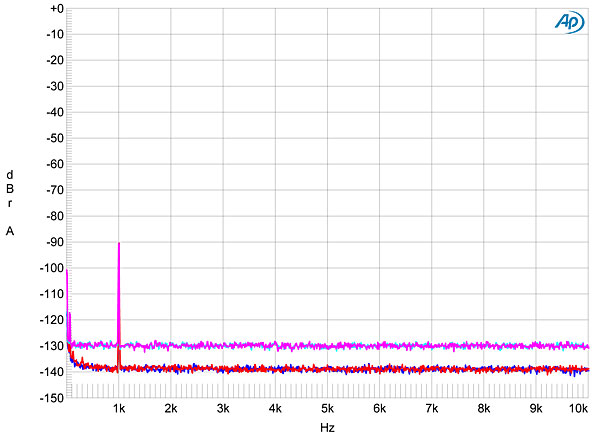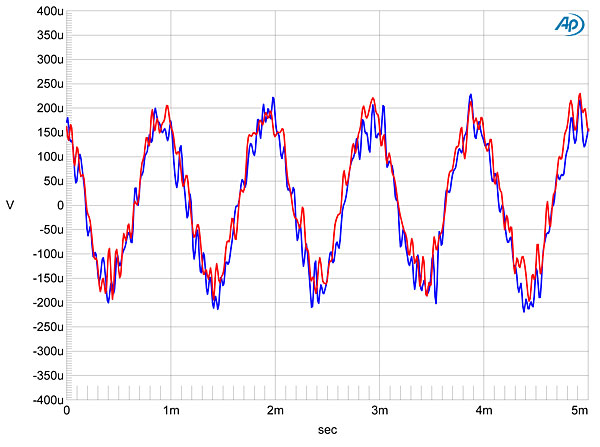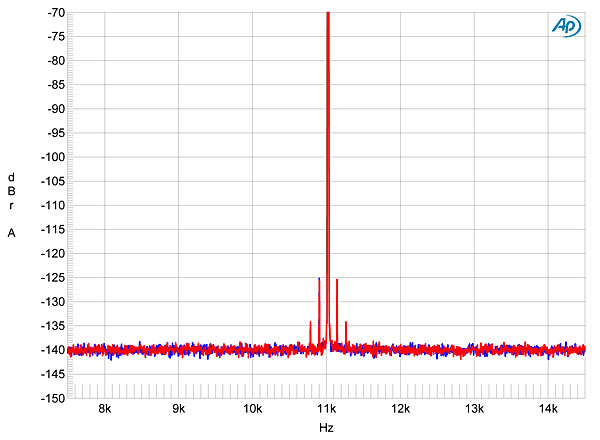| Columns Retired Columns & Blogs |
Hi! Was DX-5 connected to the system via the balanced output? If that's the case, what's the XLR input polarity of DartZeel? I could not find this information on DartZeel's website. Thanks.
I mostly used Stereophile's loan sample of the top-of-the-line Audio Precision SYS2722 system to perform the measurements on the Ayre Acoustics DX-5 (see the January 2008 "As We See It" and www.ap.com); for some tests, I also used my vintage Audio Precision System One Dual Domain and the Miller Audio Research Jitter Analyzer. I have CDs, DVD-As, and SACDs with test signals, but as of yet I have no Blu-ray test disc. However, it is safe to assume that the Ayre DX-5's performance with 24-bit audio stored on BD-Audio discs will be the same as with 24-bit DVD-As.
The maximum output level with CD and DVD-A was 3.84V from the balanced output, but only 1.8V with SACD. The level from the unbalanced output was half those figures, as expected, sourced from a low impedance of 69 ohms at all audio frequencies. The balanced output impedance was twice that, again as expected, at 139 ohms. The DX-5's outputs preserved absolute polarity (ie, were non-inverting) with all media with which I tried it. (The balanced XLRs are wired with pin 2 hot.) Tested with the Pierre Verany Test CD, whose pit spiral contains laser-cut gaps of various lengths, the Ayre DX-5's error correction was the best I have encountered. It wasn't until there were two 3mm gaps in series that the player stumbled, and then only briefly. Good gracious!
Tested with my MacBook, the DX-5's USB input operated correctly with data having sample rates of 44.1, 48, 88.2, and 96kHz, and bit depths of 16 and 24. Data sampled at 32, 176.4, and 192kHz were sample-rate–converted by the host computer to whatever the rate of the last file played had been. (I understand that a forthcoming firmware upgrade will allow the higher sample rates to be handled correctly.) Connected to the Audio Precision digital input with a true 110 ohm Canare cable and tested with 16-bit J-Test data, the Ayre's AES/EBU digital output offered low datastream jitter, measuring between 345 and 394 picoseconds peak.
The DX-5 offers two choices of digital reconstruction filter, Measure and Listen. The latter gives a slightly early rolloff with both CD and DVD data (–3dB at 20kHz and 39kHz, respectively; fig.1, blue and red traces) and less rejection of ultrasonic images, while the Measure filter behaves more conventionally (fig.1, cyan and magenta traces), with a very steep rolloff just below the Nyquist Frequency (half the sample rate). With SACD playback (fig.1, top pair of traces), the ultrasonic rolloff continues the smooth contour seen with PCM data and the Measure filter, reaching –6dB at 85kHz. Fig.2 shows the impulse response of the Listen filter. There is no pre-ringing, and just a single cycle of post-ringing. I haven't shown the Measure impulse response, but it is similar to that of Meridian's "apodizing" filter (see fig.2 in the QB-9 review.)

Fig.1 Ayre Acoustics DX-5, frequency response at –12dBFS into 100k ohms from balanced outputs with data sampled at 44.1 and 96kHz with Measure reconstruction filter (left channel cyan, right magenta), and with Listen filter and DSD data (left blue, right red). (1dB/vertical div.)

Fig.2 Ayre Acoustics DX-5 set to Listen, response to single sample at 0dBFS, 44.1kHz sampled data (4ms time window).
Channel separation was superb, at 116dB at 1kHz, and still 86.5dB at 50kHz. Noise levels were also very low, though when a CD was paused, there were spuriae present at 352.8kHz at 35mV.
For consistency with my previously published tests of digital components, I first examine resolution by sweeping a 1/3-octave–wide bandpass filter from 20kHz to 20Hz while the device under test decodes dithered data representing a 1kHz tone at –90dBFS. The top pair of traces below 4kHz in fig.3 show an analysis of the DX-5's balanced output with 16-bit data. The peak just touches the –90dB line, implying minimal linearity error, and other than a slight bump in the right channel's output at 60Hz, the noise floor is actually the dither noise used to encode the signal. Repeating the test with 24-bit data played back from a DVD-A gave the bottom pair of traces in fig.3. The noise floor has dropped by 10dB, suggesting a DAC resolution of around 18 bits, which is similar to the performance of Ayre's QB-9 processor, and again there is a slight amount of a 60Hz tone present in the right channel only. (At –118dBFS, this is not going to disturb anyone's musical enjoyment.) The lower maximum output level with SACD, however, results in a noise floor no better at low and middle frequencies than that with the same signal played back from CD (fig.3, top traces above 4kHz).

Fig.3 Ayre Acoustics DX-5, 1/3-octave spectrum with noise and spuriae of dithered 1kHz tone at –90dBFS with: 16-bit data (top below 4kHz), 24-bit data (bottom), DSD data (top above 4kHz). (Right channel dashed.)
Repeating the spectral analysis with the 16- and 24-bit signals but now using an FFT technique again gives a 10dB lowering of the noise floor (fig.4), but the spectra are commendably free from spuriae other than the 60Hz component noted earlier. Fig.5 shows the waveform of an undithered 16-bit/1kHz tone at exactly –90.31dBFS; the three discrete DC voltage levels described by the data are clearly resolved, with excellent waveform symmetry. Increasing the data's bit depth to 24 gave rise to a well-defined sinewave (fig.6). DAC linearity error with 16-bit data was vanishingly low to below –110dBFS (not shown).

Fig.4 Ayre Acoustics DX-5, FFT-derived spectrum with noise and spuriae of dithered 1kHz tone at –90dBFS with: 16-bit data (left channel cyan, right magenta), 24-bit data (left blue, right red).

Fig.5 Ayre Acoustics DX-5, waveform of undithered 1kHz sinewave at –90.31dBFS, 16-bit data (left channel blue, right red).

Fig.6 Ayre Acoustics DX-5, waveform of undithered 1kHz sinewave at –90.31dBFS, 24-bit data (left channel blue, right red).
Into the high 100k ohms lab test load, the Ayre's balanced distortion signature with 24-bit data—what there was of a signature—consisted of the third harmonic at –77dB (0.014%), the second at –87dB (0.004%), and the fifth at –100dB (0.001%). Dropping the load impedance to a punishing 600 ohms somewhat raised the levels of the odd harmonics (fig.7), but not to anything like levels that might be audible. The "leaky" ultrasonic nature of Ayre's Listen filter gives rise to poor image rejection with the high-level mix of 19 and 20kHz tones, as well as some audioband aliasing (fig.8), though actual intermodulation distortion is very low. Switching to the Measure filter cleans up the spectrum nicely (fig.9).

Fig.7 Ayre Acoustics DX-5, spectrum of 50Hz sinewave, DC–10kHz, at 0dBFS into 600 ohms (left channel blue, right red; linear frequency scale).

Fig.8 Ayre Acoustics DX-5, Listen, HF intermodulation spectrum, DC–24kHz, 19+20kHz at 0dBFS into 100k ohms (linear frequency scale).

Fig.9 Ayre Acoustics DX-5, Measure, HF intermodulation spectrum, DC–24kHz, 19+20kHz at 0dBFS into 100k ohms (linear frequency scale).
From the conversations I have had with him over the past couple of years, I know that Ayre's Charlie Hansen takes jitter rejection very seriously. Measuring the DX-5 using the 16-bit J-Test signal played back on CD or DVD, or fed to the Ayre's USB port, gave identical spectra (fig.10, footnote 1). The harmonics of the low-frequency squarewave are at the residual level, and the only sidebands visible lie 120Hz to either side of the central spike representing the high-level 11.025kHz tone. Repeating the analysis with a 24-bit version of the J-Test signal gave a beautifully clean spectrum (fig.11), though the supply-related sidebands at ±120Hz are still present, and another pair can be seen at ±240Hz, just above the noise floor at –140dBFS.

Fig.10 Ayre Acoustics DX-5, high-resolution jitter spectrum of analog output signal, 11.025kHz at –6dBFS, sampled at 44.1kHz with LSB toggled at 229Hz, 16-bit data from MacBook via USB. Center frequency of trace, 11.025kHz; frequency range, ±3.5kHz (left channel blue, right red).

Fig.11 Ayre Acoustics DX-5, high-resolution jitter spectrum of analog output signal, 11.025kHz at –6dBFS, sampled at 44.1kHz with LSB toggled at 229Hz, 24-bit data from DVD-A. Center frequency of trace, 11.025kHz; frequency range, ±3.5kHz (left channel blue, right red).
It is a pleasure to measure such a well-engineered product as Ayre's DX-5. This "universal A/V engine" may be based on an Oppo chassis, but its measured performance, especially via that asynchronous USB port, is pure Ayre Acoustics!—John Atkinson

Hi! Was DX-5 connected to the system via the balanced output? If that's the case, what's the XLR input polarity of DartZeel? I could not find this information on DartZeel's website. Thanks.
